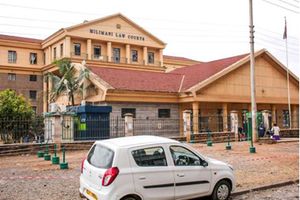Premium
Africa’s tallest building dream now lies in ruins
What you need to know:
- The building was expected to have been completed by the end of last year.
- The project that was to cost at least Sh20 billion has long stalled.
- Water and debris have filled up an excavation that had been dug to accommodate a four-level basement.
- A front-facing banner conceals the massive hole but parts of the site are unfenced.
It started as an ambitious project to build Africa’s tallest building but three years after a launch attended by President Uhuru Kenyatta, all there is at the site is a massive gaping hole posing danger to lives and property in Nairobi’s Upper Hill.
Had things gone according to plan, today an imposing structure known as The Pinnacle would be standing tall along Upper Hill Road, with concrete, glass and steel being piled up to push it towards a breath-taking 300-metres, dwarfing every building ever erected on the continent — including Johannesburg's 234-metre.
However, the project that was to cost at least Sh20 billion has long stalled, with water and debris filling up an excavation that had been dug to accommodate a four-level basement.
A front-facing banner conceals the massive hole but parts of the site are unfenced, raising safety concerns. Worse still, the Nation has learnt, some of those occupying nearby buildings have complained to the authorities that the abandoned site is affecting their structures, with some reporting cracks attributed to the excavated area.
The National Construction Authority (NCA) declined to comment on whether it had received complaints. Its corporate communications team directed us to a general public notice on deep excavations published on September 1 where NCA gave 30 days to all developers who have dug up excavations more than three metres deep to submit a report detailing the slope stability, how they are monitoring the excavations and detailed studies on how the excavations are affecting adjacent structures.
“Developers with abandoned construction sites and deep excavations shall present to the authority a structural integrity report from a structural engineer within a period of 30 days from the date of this notice and a plan to proceed with works,” the notice read.
“In the absence of the report, the authority will recommend necessary remedial action including but not limited to demolition and or repossession of the land by the government of Kenya in line with the conditions of the title,” it added.
Refill excavations
NCA further noted that developers who do not have a plan for further development of the construction projects they are handling should draw water and refill the excavations by end of September.
The National Environment Management Authority did not immediately respond to our queries on the site.
Buildings near the stalled Pinnacle project include Mwalimu Towers that is just a few metres away and the 22-storey Rahimtulla Tower. The Mwalimu Sacco CEO did not respond to an enquiry from the Nation as to whether the 17-floor Sacco building has been affected.
The gloomy outlook of The Pinnacle is in sharp contrast to the bright prospect on May 23, 2017 when President Kenyatta laid the foundation stone for its construction.
“This future icon will be a proud symbol of collaboration and the peak of architectural achievement in Africa,” said a press release sent on the day of the launch.
Completion date
Expected to have been completed by the end of last year, The Pinnacle was to be developed jointly by Jabavu Village, the real estate arm of Hass Petroleum Group, and White Lotus Group — a Dubai-based conglomerate with interests in real estate, mining, petrochemicals, sports, among others.
Neither of the two companies could be reached for comment.
At the time the President laid the foundation stone, a publicist told the Sunday Nation that the planned total excavation was 65 metres.
The building was to have a shopping and entertainment component at the base and a five-star hotel above the shopping space.
“The hotel is designed as a 45-storied high tower standing above the low-rise retail development,” the publicists, who no longer work with White Lotus, said then.
Within the building, there would also be 42 floors of residential apartments and 20 floors of office space. On its two top most floors, there was to be a space for people to have views of the landscape with promises of seeing “spectacular views of Mt Kilimanjaro and Mt Kenya”.
Movement up and down was to be facilitated by 1,350 kilogramme lifts with a speed of six metres per second, meaning it would take under a minute to go from the ground floor to the top most floor.
Hurdles
But there have been hurdles: some thought to do with financing; others posed by court cases.
Owners of a disputed piece of land adjacent to The Pinnacle site had gone to court as far back as 2016 and accused The Pinnacle management of trespassing through debris and construction equipment.
The case was filed by Ugandan tycoon James Mugoya through his Kingorani Investments and a trust formed by former United Arab Emirates leader Sheikh Zayeed Nayan.
A court order was issued in January 2017 barring the constructors from using the neighbouring plot. That, however, did not deter The Pinnacle constructors. Consequently, High Court judge Samson Okong’o declared in December 2018 that the directors of White Lotus had acted in contempt of court.
Following the complicated and vicious court battle, the developers dropped their use of the adjacent pieces of land for storage, ending the controversy.
However, construction has barely proceeded thereafter, raising the current safety concerns.






